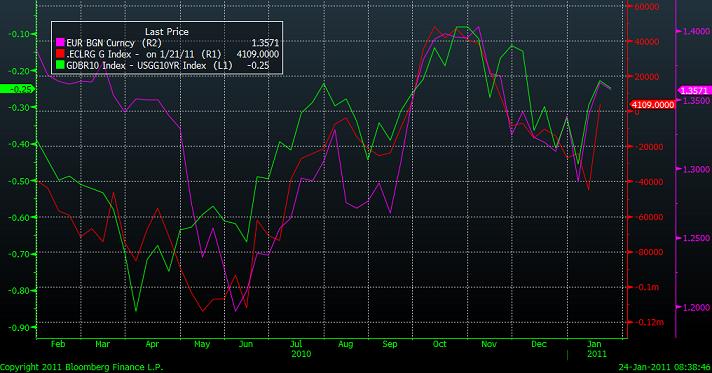Is the euro due a pullback and has support for the Aussie withered?
Is the euro ripe for a pullback vs. the dollar?
....But less so versus the pound
Are fundamental supports eroding for the Aussie?
It’s a busy week for economic data, the highlights include UK and US Q4 GDP, a Federal Reserve meeting, Bank of England minutes from the MPC meeting earlier this month and the Bank of Japan also meets today and tomorrow. This should be enough to create some volatility in FX markets.
The euro:
With European data taking a back seat, recent euro strength could be due a pull-back
The chart below shows EURUSD (pink line), the spread between 10-year German and US government debt and CFTC positioning data on speculative long EURUSD position (red line).
As you can see, the rise in long euro positions has coincided with the widening in the spread between German and US government bond yields. This suggests that the ECB’s perceived hawkishness on the back of rising inflation has driven much of the strength in the euro.
But the interest rate spread between German and US rates and EURUSD look like they might be pulling back a little as we start the new week. We will hear more from the Fed this week at the January FOMC meeting that concludes this Wednesday. Any sign that the Fed is less dovish than the market thinks may see a swift reversal of long EURUSD positions as traders readjust their relative interest rate expectations.
EUR/USD, German-US 10-year bond yields and CFTC speculative long EURUSD positioning.

In contrast, the spread between German and UK 10-year bonds haven’t widened as much, and EURGBP hasn’t experienced as sharp an up-move – it has risen 2.5% this year, vs. EURUSD, which is up more than 5 per cent.
Thus, if UK GDP for the fourth quarter, released tomorrow at 0930 GMT, is below the 0.5 per cent the market expects then we could see EURGBP extend its gains, as the market starts to price out early rate rises by the Bank of England.
Flood damage and a reduction in inflation pressures is taking the pressure off the Reserve Bank of Australia (RBA) to hike rates. This is weighing on the Aussie, especially versus euro. This is no surprise, for most of last year the Aussie was the strongest currency and the euro was the weakest, as we start 2011 we are seeing some of these themes reverse.
The reduction in the interest rate differential has sent the spread between German bunds and Australian government bond yields surging (although they remain negative) from -3.6% to -3.06%. This marked the bottom on EURAUD.
We would warn that any dovish comments from the ECB/ hawkish ones from the RBA could see EURAUD to reverse. However, the recent break higher could see back to the 1.40 zone.
Источник: FOREX.com
24.01.2011



 Динамика валютных курсов
Динамика валютных курсов